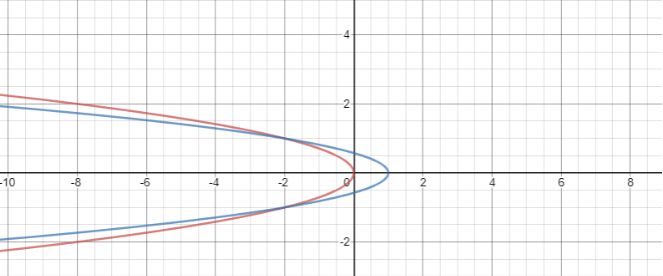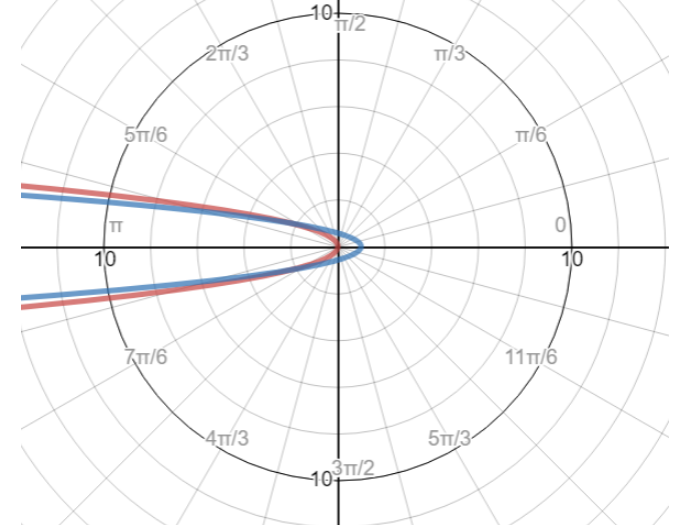
Answer
420.6k+ views
Hint:As the given equations are:
${\mathbf{x}} + {\mathbf{2}}{{\mathbf{y}}^2}{\text{ }} = {\text{ }}{\mathbf{0}}$ and ${\mathbf{x}} + {\mathbf{3}}{{\mathbf{y}}^2}{\text{ }} = {\mathbf{1}}$
And we know that the curve, having two variables in which the degree of one variable is $2$ and the other one is$1$, are of the parabola.So, to find the area of the plane region covered by these two given parabolas, we need to find the points of intersections and then need to apply integration within limits.
Complete step by step answer:
The given curves are: ${\mathbf{x}} + {\mathbf{2}}{{\mathbf{y}}^2}{\text{ }} = {\text{ }}{\mathbf{0}}$ and ${\mathbf{x}} + {\mathbf{3}}{{\mathbf{y}}^2}{\text{ }} = {\mathbf{1}}$


In the case of the first curve:
${\mathbf{x}} + {\mathbf{2}}{{\mathbf{y}}^2}{\text{ }} = {\text{ }}{\mathbf{0}}$
i.e. ${\mathbf{x}} = - {\mathbf{2}}{{\mathbf{y}}^2}$
i.e. $\dfrac{{ - x}}{2} = {{\mathbf{y}}^2}$
This is the equation of left-handed parabola having the vertex $\left( {0,0} \right).$
In case of second parabola:
This is also the equation of parabola.
So, to find the area between the parabolas, we just need to find the area points of intersection of these two curves.
As we know: ${{\mathbf{y}}^2} = {{\mathbf{y}}^2}$
putting different values of on both the sides:
i.e. $\dfrac{{ - x}}{2} = \dfrac{{1 - x}}{3}$
solving and arranging the terms:
i.e. $ - 3x + 2x = 2$
$x = - 2$
Therefore, putting the value of in the equation of first curve i.e ${y^2} = \dfrac{{ - x}}{2}$
it becomes, ${y^2} = \dfrac{{ - ( - 2)}}{2} = 1$
i.e. ${y^2} = \dfrac{{ - ( - 2)}}{2} = 1$
i.e. ${y^{{2^{}}}} = 1$ ${y^2} = 1$
$y = 1, - 1$
Hence, there are two points of intersection $\left( { - 2, - 1} \right){\text{ }}and{\text{ }}\left( { - 2,1} \right)$
Now, to find the required area, we are going to integrate the curve equation w.r.t y taking limits from $\_1{\text{ }}to{\text{ }}1$.
Hence, required area:
$|\int\limits_{ - 1}^1 {\left( {x + 3{y^2} - 1} \right)dy|} $
Putting the value of x from first curve I;
$|\int\limits_{ - 1}^1 {\left( {x + 3{y^2} - 1} \right)dy|} $
$\Rightarrow|\int\limits_{ - 1}^1 {\left( { - 2{y^2} + 3{y^2} - 1} \right)dy|} $
$\Rightarrow |\int\limits_{ - 1}^1 {\left( {{y^2} - 1} \right)dy|} $
We also know that by doubling the integrand if the limits are $-a{\text{ }}to{\text{ }}a$, we can change it to $0{\text{ }}to{\text{ }}a.$
Therefore, Required area $ = 2|\int\limits_0^1 {\left( {{y^2} - 1} \right)dy|} $
$\Rightarrow 2\left( {\dfrac{{{y^3}}}{3} - y} \right)_0^1$
$\Rightarrow 2\left( {\left( {\dfrac{1}{3} - 1} \right) - \left( {\dfrac{0}{3} - 0} \right)} \right)_0^1$
$\Rightarrow 2| - \dfrac{2}{3}|$
Solving the modulus; $ = \dfrac{4}{3}$ square units
Note: Parabola is one of the important curves in mathematics. There are major four types of parabola i.e:
a. Upward Parabola represented by equation: $\int\limits_a^b {kdt} = \left[ {kt} \right]_a^b = kb - ka = k(b - a)$ ${(x - h)^2} = 4p(y - k)$
b. Downward parabola represented by equation: ${(x - h)^2} = - 4p(y - k)$
c. Left handed parabola represented by equation: ${(y - k)^2} = - 4p(x - h)$
d. Right handed parabola represented by equation: ${(y - k)^2} = 4p(x - h)$
having vertex (h,k)
To find the area of the plane region covered by two curves, we usually use integration within the limits of any variable.So, in this equation we did integration with respect to y and put the value of x in the form of y in the second curve from the first curve to form the integrand and the limits were of y. The formulae used in this problem are:
$\int\limits_a^b {{t^n}dt} = \left[ {\dfrac{{{t^{n + 1}}}}{{n + 1}}} \right]_a^b = \dfrac{{{b^{n + 1}}}}{{n + 1}} - \dfrac{{{a^{n + 1}}}}{{n + 1}}$
and $\int\limits_a^b {kdt} = \left[ {kt} \right]_a^b = kb - ka = k(b - a)$
Hence, by doing all these calculations, the correct option is ‘B’ i.e $4/3$square units.
${\mathbf{x}} + {\mathbf{2}}{{\mathbf{y}}^2}{\text{ }} = {\text{ }}{\mathbf{0}}$ and ${\mathbf{x}} + {\mathbf{3}}{{\mathbf{y}}^2}{\text{ }} = {\mathbf{1}}$
And we know that the curve, having two variables in which the degree of one variable is $2$ and the other one is$1$, are of the parabola.So, to find the area of the plane region covered by these two given parabolas, we need to find the points of intersections and then need to apply integration within limits.
Complete step by step answer:
The given curves are: ${\mathbf{x}} + {\mathbf{2}}{{\mathbf{y}}^2}{\text{ }} = {\text{ }}{\mathbf{0}}$ and ${\mathbf{x}} + {\mathbf{3}}{{\mathbf{y}}^2}{\text{ }} = {\mathbf{1}}$


In the case of the first curve:
${\mathbf{x}} + {\mathbf{2}}{{\mathbf{y}}^2}{\text{ }} = {\text{ }}{\mathbf{0}}$
i.e. ${\mathbf{x}} = - {\mathbf{2}}{{\mathbf{y}}^2}$
i.e. $\dfrac{{ - x}}{2} = {{\mathbf{y}}^2}$
This is the equation of left-handed parabola having the vertex $\left( {0,0} \right).$
In case of second parabola:
This is also the equation of parabola.
So, to find the area between the parabolas, we just need to find the area points of intersection of these two curves.
As we know: ${{\mathbf{y}}^2} = {{\mathbf{y}}^2}$
putting different values of on both the sides:
i.e. $\dfrac{{ - x}}{2} = \dfrac{{1 - x}}{3}$
solving and arranging the terms:
i.e. $ - 3x + 2x = 2$
$x = - 2$
Therefore, putting the value of in the equation of first curve i.e ${y^2} = \dfrac{{ - x}}{2}$
it becomes, ${y^2} = \dfrac{{ - ( - 2)}}{2} = 1$
i.e. ${y^2} = \dfrac{{ - ( - 2)}}{2} = 1$
i.e. ${y^{{2^{}}}} = 1$ ${y^2} = 1$
$y = 1, - 1$
Hence, there are two points of intersection $\left( { - 2, - 1} \right){\text{ }}and{\text{ }}\left( { - 2,1} \right)$
Now, to find the required area, we are going to integrate the curve equation w.r.t y taking limits from $\_1{\text{ }}to{\text{ }}1$.
Hence, required area:
$|\int\limits_{ - 1}^1 {\left( {x + 3{y^2} - 1} \right)dy|} $
Putting the value of x from first curve I;
$|\int\limits_{ - 1}^1 {\left( {x + 3{y^2} - 1} \right)dy|} $
$\Rightarrow|\int\limits_{ - 1}^1 {\left( { - 2{y^2} + 3{y^2} - 1} \right)dy|} $
$\Rightarrow |\int\limits_{ - 1}^1 {\left( {{y^2} - 1} \right)dy|} $
We also know that by doubling the integrand if the limits are $-a{\text{ }}to{\text{ }}a$, we can change it to $0{\text{ }}to{\text{ }}a.$
Therefore, Required area $ = 2|\int\limits_0^1 {\left( {{y^2} - 1} \right)dy|} $
$\Rightarrow 2\left( {\dfrac{{{y^3}}}{3} - y} \right)_0^1$
$\Rightarrow 2\left( {\left( {\dfrac{1}{3} - 1} \right) - \left( {\dfrac{0}{3} - 0} \right)} \right)_0^1$
$\Rightarrow 2| - \dfrac{2}{3}|$
Solving the modulus; $ = \dfrac{4}{3}$ square units
Note: Parabola is one of the important curves in mathematics. There are major four types of parabola i.e:
a. Upward Parabola represented by equation: $\int\limits_a^b {kdt} = \left[ {kt} \right]_a^b = kb - ka = k(b - a)$ ${(x - h)^2} = 4p(y - k)$
b. Downward parabola represented by equation: ${(x - h)^2} = - 4p(y - k)$
c. Left handed parabola represented by equation: ${(y - k)^2} = - 4p(x - h)$
d. Right handed parabola represented by equation: ${(y - k)^2} = 4p(x - h)$
having vertex (h,k)
To find the area of the plane region covered by two curves, we usually use integration within the limits of any variable.So, in this equation we did integration with respect to y and put the value of x in the form of y in the second curve from the first curve to form the integrand and the limits were of y. The formulae used in this problem are:
$\int\limits_a^b {{t^n}dt} = \left[ {\dfrac{{{t^{n + 1}}}}{{n + 1}}} \right]_a^b = \dfrac{{{b^{n + 1}}}}{{n + 1}} - \dfrac{{{a^{n + 1}}}}{{n + 1}}$
and $\int\limits_a^b {kdt} = \left[ {kt} \right]_a^b = kb - ka = k(b - a)$
Hence, by doing all these calculations, the correct option is ‘B’ i.e $4/3$square units.
Recently Updated Pages
Who among the following was the religious guru of class 7 social science CBSE

what is the correct chronological order of the following class 10 social science CBSE

Which of the following was not the actual cause for class 10 social science CBSE

Which of the following statements is not correct A class 10 social science CBSE

Which of the following leaders was not present in the class 10 social science CBSE

Garampani Sanctuary is located at A Diphu Assam B Gangtok class 10 social science CBSE

Trending doubts
A rainbow has circular shape because A The earth is class 11 physics CBSE

Which are the Top 10 Largest Countries of the World?

Fill the blanks with the suitable prepositions 1 The class 9 english CBSE

How do you graph the function fx 4x class 9 maths CBSE

The Equation xxx + 2 is Satisfied when x is Equal to Class 10 Maths

What is BLO What is the full form of BLO class 8 social science CBSE

Give 10 examples for herbs , shrubs , climbers , creepers

What organs are located on the left side of your body class 11 biology CBSE

Change the following sentences into negative and interrogative class 10 english CBSE




